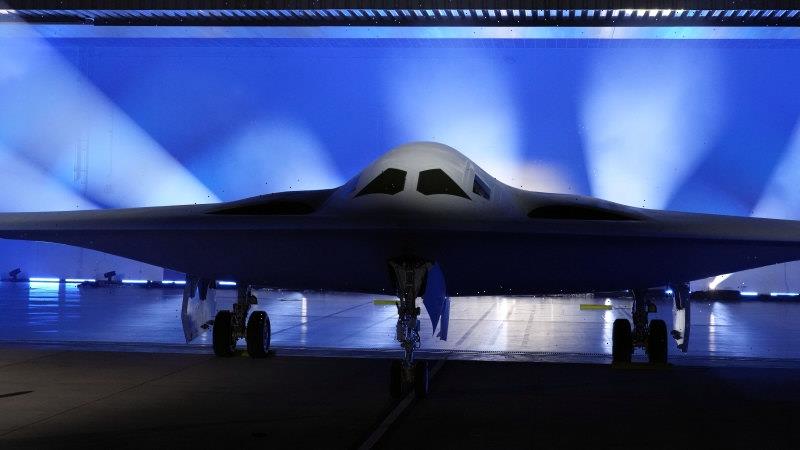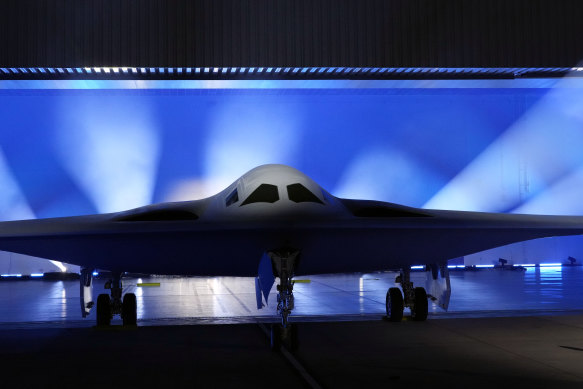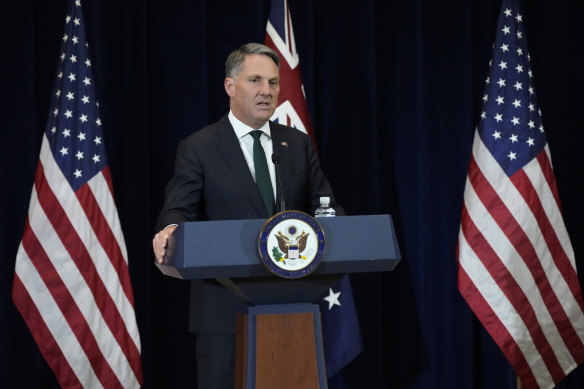Defence analysts are urging the Albanese government to closely examine spending almost $30 billion on recently unveiled long-range strike bombers from the United States as it overhauls the nation’s defence forces to prepare for a possible conflict with China.
While acknowledging that securing a squadron of B-21 bombers would be costly and controversial, respected military analyst Marcus Hellyer said the aircraft’s potential to reach as far as mainland China from Australia would make it a highly attractive asset for the Australian Defence Force.
The B-21 Raider stealth bomber was unveiled in California earlier this month.Credit:AP
The B-21s could even plug a looming capability gap for the Australian Navy by serving as an “interim submarine” while Australians await a fleet of nuclear-powered submarines under the AUKUS pact, Hellyer argues in a new report for the Australian Strategic Policy Institute (ASPI).
“We’ve enjoyed the benefit of a tyranny of distance from China, but that could end very quickly,” said Hellyer, a former senior Defence Department official.
“We need to prepare for an increasingly ambitious Chinese Communist Party and increasingly powerful People’s Liberation Army.”
US Defence Secretary Lloyd Austin unveiled the aircraft, the first new US strategic bomber in more than three decades, at a dramatic dusk ceremony in California earlier this month, declaring: “no other long-range bomber can match its efficiency.”
Royal Australian Air Force Chief Rob Chipman attended the event, applauding it on Twitter as an “awesome display of US innovation and industrial power”.
Defence Minister Richard Marles has said he wants the Australian Defence Force to be capable of “impactful projection”.Credit:AP
Defence Minister Richard Marles described the B-21 – which resembles a flying saucer and uses top-secret advanced technology to avoid radar detection – as a “very cool looking” aircraft during a visit to Washington last week.
Hellyer said stealth bombers like the B-21 aligned with Marles’ vision, articulated in several recent speeches, to reshape the Australian Defence Force (ADF) around a doctrine of “impactful projection”.
“Unfortunately, the ADF’s strike cupboard is rather bare,” Hellyer and co-author Andrew Nicholls write in their new ASPI report.
“Defence is acquiring more modern maritime strike and land-attack missiles for its existing platforms.
“But, even if equipped with better weapons, strike systems built around fighter planes or surface combatants are unlikely to have the ‘affordable mass’ or range needed to deter or defeat a major power’s attempts to project force against Australia.”
Hellyer and Nicholls, a former adviser to three defence ministers, note that long-range bombers can travel significantly further and carry more weapons than Australia’s F-35A fighter jets.
Estimating a squadron of 12 B-21s would cost between $25-$28 billion, Hellyer and Nicholls accept other Defence projects would need to be cancelled or wound back to free up enough money for the project.
Among the B-21’s detractors are Australian National University emeritus professor Hugh White, who has argued they “make little or no operational sense for Australia”.
Retired major general Mick Ryan recently wrote in The Sydney Morning Herald and The Age: “Designed to do only one thing – bomb China – the B-21 bomber is a capability beyond Australia’s budget and needs.”
Hellyer and Nicholls write that, while there are arguments against the B-21, the AUKUS agreement showed “the world has changed”.
“Things that were previously inconceivable are now happening, so we shouldn’t dismiss the B-21 out of hand,” Hellyer and Nicholls argue.
“Our recommendation is that the Australian government should engage with the US government to gain access to the information on the B-21program so they can make an informed decision on its viability for Australia.”
They continue: “The B-21 certainly has a high sticker price, but if, by virtue of its stealth, it can employ cheaper, short-range weapons, then in the long run it may be more affordable and deliver greater effects than long-range missiles alone.”
They say the case for Australia acquiring a long-range strike capability is less about a potential conflict in Taiwan than a “worst case scenario” in which China or another adversary establishes a military presence close to Australia’s shores in the Pacific or South-East Asia.
Austin, the US Defence Secretary, said last week he would like to get the first B-21 “tested and fully outfitted” before he discusses selling it to other countries such as Australia.
“And as you know, we have a ways to go before we do that,” he said.
Cut through the noise of federal politics with news, views and expert analysis from Jacqueline Maley. Subscribers can sign up to our weekly Inside Politics newsletter here.
Most Viewed in Politics
From our partners
Source: Read Full Article


